The Knowledge That Won't Fit Inside Your Head Part 2 - Index Cards and Antinets
The Zettelkasten method allows you to document information in an Antinet to help supercharge your learning, writing and creative work
In the next installment of The Knowledge That Won’t Fit Inside of Your Head we continue our discussion of paper-based knowledge management (see Part 1 about commonplace books here). We’ll talk about the Zettelkasten method, an Antinet, or something very similar, in this post.
Introduction to the Zettelkasten method
Commonplace books are a great way to put valuable knowledge on paper so you can revisit it in the future. Authors like Ryan Holliday and Robert Greene use a variation on the commonplace book where they store tons of information on index cards, sorted by themes, so they can refer to them quickly and individually. This method has been used by a number of performers, creatives and celebrities to store their information outside of their brains yet keep it available for fast retrieval and use.
One variation on this practice which is well known by people who study and use knowledge management techniques is the Zettelkasten method.1 One of the best known practitioners was a German scientist named Niklas Luhmann. From zettelkasten.de:
Niklas Luhmann was a highly productive social scientist. He published 50 books and over 600 articles. He didn’t achieve this on his own. He had quite a companion.
There are also over 150 unfinished manuscripts left in his estate. At least one of them is a text of 1000 pages. So his productivity surpassed even his already astonishing body of published work.
Luhmann himself stated that his productivity stems from working in a partnership with his Zettelkasten. This strikes a chord with people investigating the Zettelkasten Method.
The term zettelkasten is a German word which joins two key concepts:
zettel: note
kasten: box (or crate)
Literally translated, Zettelkasten means note box and that’s exactly what Luhmann used, a box where he stored information written on slips of paper that he would reuse and combine over time to deliver a staggering amount of material. Luhmann lived from 1927 to 1998 , so personal computers and the Internet were only available towards the end of his life.
Special note: there is a trend to refer to a paper-based Zettelkasten as an Antinet. For this post I’ll continue to use the term Zettelkasten but be aware there there is also a company or product with the name Zettelkasten which is not the same thing.
Key components of a Zettelkasten
The kasten is the easy part, many kinds of boxes will do if there are big enough to hold an index card. If you are in a pinch, you can take a club pack of granola bars, which is the right width for index cards!
The work is in the zettels.
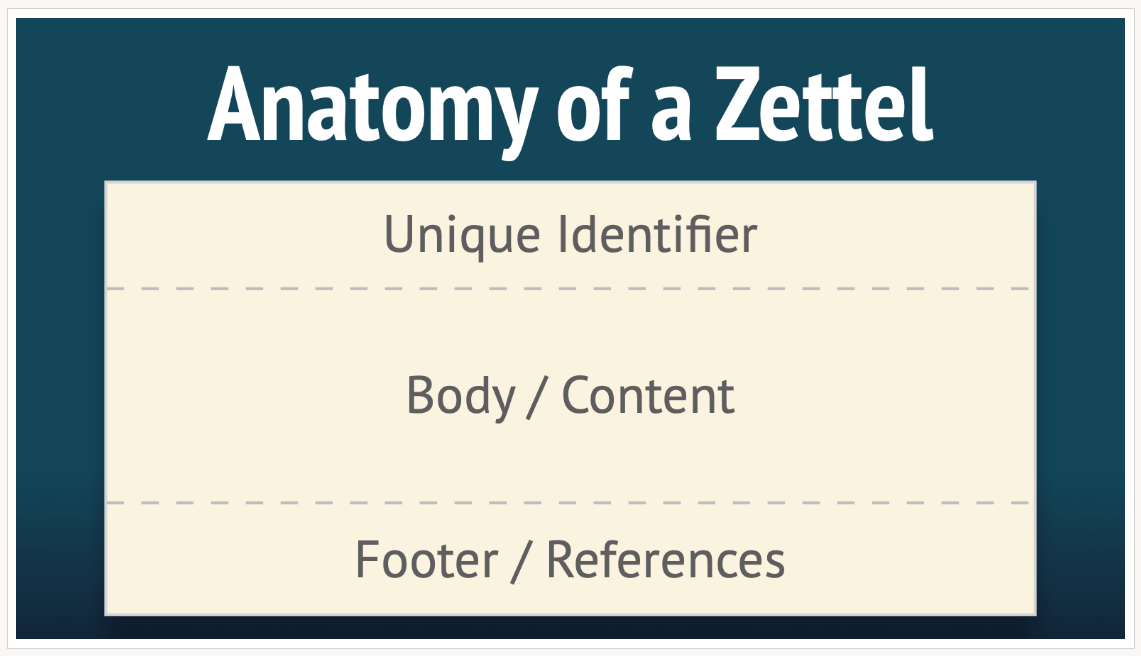
A zettel (or Zettel) is a note: a record of information that you want to preserve from the books, articles, posts and blogs you’ve read, the videos you’ve seen or the audiobooks, TV programs, speeches and podcasts that you’ve heard. Note: throughout this post I will use the terms Zettel and card interchangeably.
I’ll talk about how how I’m making my Zettelkasten using pen and paper (and tape!) in this post but there are plenty of apps available that can be used to build a Zettelkasten.
Looking at the anatomy of a Zettel in more detail:
Unique Identifier
Each Zettel must have a unique identifier, like a serial number, an address or some other unique way to identify each Zettel. Luhmann used a sequential numbering system, starting with 1 and incrementing upward. Occasionally he would insert cards into his existing collection of cards and he would use suffixes to denote where the card belonged in sequence. Other people use longer numbers to give themselves more flexibility.
When I create a new Zettel I check the current date/time and use it to create an unique Identifier in the following format: YYYYMMDDHHMM.
Body/Content
This is the key information that you want to store about the topic. It could be a word-for-word duplication of some piece of information, like a quote. Or, as others recommend, the content should be a summary of your understanding of the particular piece of information. Taking this extra step helps with both comprehension and retention of the information.
It’s recommended that you summarize the information you want to store in your own words, instead of directly copying the information like you would in a commonplace book.
Another good practice is to give your Zettel a title for easy reference. This is not the same as the unique identifier! Instead, it just allows you to quickly know the card's subject at a glance.
Zettel contents should be created by following the Principle of Atomicity. In its purest form, this means that a Zettel should encapsulate a single idea or thought, just like an atom was once considered to be the smallest form of matter. If you think of a typical article or Wikipedia entry you know that they can contain thousands of words and discuss multiple concepts. A Zettel is the equivalent to a single concept: a summary, in your own words, of one paragraph or even one sentence that explains one thing.
Here’s a simple example:
A rainbow has many colors but there are seven key ones: red, orange, yellow, green, blue, indigo and violet. If you were to make a Zettelkasten about a rainbow, you might have a separate Zettel for each color: seven Zettels. You could describe the key concept of each color on a separate Zettel and together they would form a small and simple Zettelkasten about rainbows.
One of the powerful capabilities of the Content section is to use the Unique Identifier of another Zettel to link the Zettel to another Zettel, creating a manual hyperlink. These are also referred to as connections.
Footer/References: you can reference the source of the information in this section of the Zettel or you could add information like topic names or tags to help use the information later on. There’s another kind of card, a Reference card, which allows you to track all of your Zettel references, plus it allows you to abbreviate the name of each reference document, taking up less space on every Zettel.
The Footer is a useful place to write tags or keywords for future reference.
Other types of cards
Zettels alone have value but there are other cards which make a Zettelkasten more useful and powerful.
Reference
The Reference card is a listing of the specific documents that are the original source of information for Zettels. It allows you to provide specific information about each reference document as well as creating an abbreviation for each one that can be used on each Zettel's footer, saving space.
Index
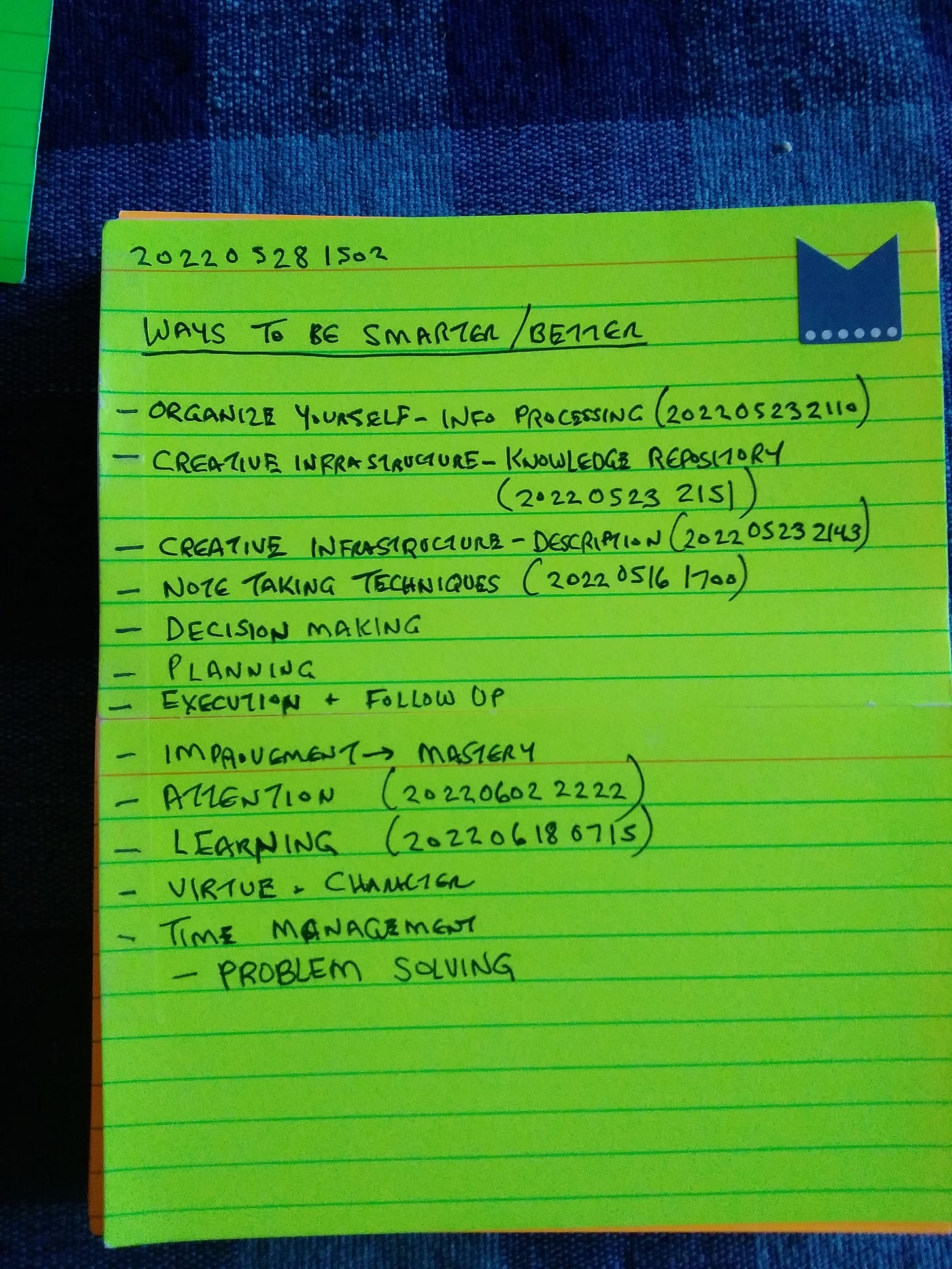
Indexes are listing of topics that are contained within your Zettelkasten: it's a table of contents. They provide a useful level of organization that makes the Principle of Atomicity more manageable, as per the above example. The card above is my master index for the entire Zettelkasten, including all major topics to date. Each major topic could, in turn, have its own topic index card.
Sometimes, in order to work around some of the limitations of the Principle of Atomicity, I'll create even more specific indexes, or sub-indexes, as per the following example:
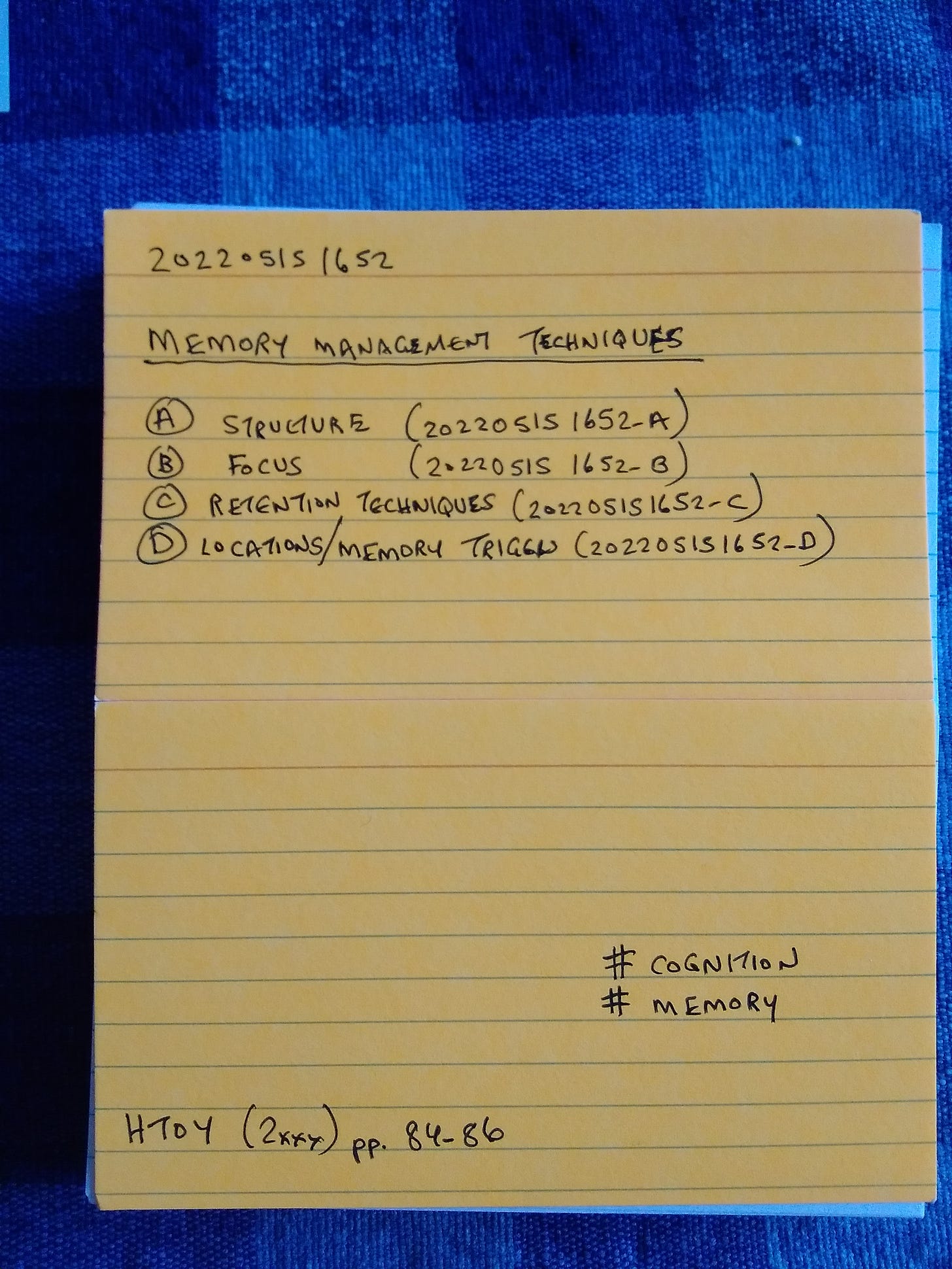
Next, here are examples of the individual cards that link back to this sub-index. Note the importance of the Unique Identifier, which allows the connections between Zettels:
Cards begin to accumulate over time! As of the time I created this post I have created nearly 100 cards and most of them are Zettels. It’s not uncommon to create hundreds, if not thousands of cards, over time.
Where the magic happens
Now, let me show you the true power of a Zettelkasten. Here’s an example of one of my most recent Zettels:
The card’s a little messy but it’s a good example of connections. If you look at the text below the name John Stuart Mill you’ll see three lines of text, each one followed by an unique identifier in parentheses. As I was reading part of a book and creating the card I remembered how this information seemed familiar. I flipped through the Zettelkasten and found that I had several Zettels with similar themes. Does this mean that this card is redundant? No, not at all!
By linking multiple Zettels you effectively find multiple supporting references for a similar concept. But… the information in each resource could be slightly different: different permutations, different references, perhaps even pros and cons. This is valuable stuff when you are reading with the end goals of learning and writing. Having a single reference for material is adequate in many cases. But when you’re writing a more complex document and really trying to master the material, it’s important to have multiple points of view: this is the work of synoptic reading, to be able to compare multiple sources on the same topic and judge how good they are.
How I have tweaked my Zettel
I don’t really know if my tweaks are unique but here are some ways that I’ve modified the standard approach a bit to personalize the method:
Zettel size
Many paper based Zettelkastens are based on 3 x 5 index cards. After trying that for a few days I found the cards weren’t big enough for me. So I began taping two cards together to make a single 6 x 5 card. Virtually all of the cards that I’ve shown in this post are made of two cards taped together. It takes some extra time to do the taping but I really like the bigger size. Plus it’s cheaper than buying cards in a custom size (I’d be glad to be proven wrong about this!)
Color
Several years ago I bought colored index cards for a writing project and I had a lot of them left over. After some experimenting I decided to use the colors as follows:
White - Zettels are on white cards
Yellow - my Master Index and next level down Topic Indexes are on yellow cards
Orange - sub-indexes are on orange cards; they are more specific than the yellow card indexes that I mentioned above. The Memory Management Techniques card shown earlier is a sub-index card
Green - reference cards are on green cards.
Stickers
I haven’t made much use of stickers, except to help make my Master Index stand out more from other yellow cards. If it makes sense I may use other stickers for quick visual identification. I haven't heard of anyone using stickers or symbols in their Zettelkasten.
Bending the Rules
When there’s a topic that has information in list form I want to retain visibility to the list. This is where I use a orange sub-index card and then white Zettel cards for the details.
Also, in some cases, I will just copy a quote onto a card instead of summarizing it if the quote is particularly succinct and powerful.
Now I’ll mention pros and cons to date of using a Zettelkasten. They are very similar to the pros and cons of commonplace books:
Pros
You work with your hands
There’s something to be said about working with your hands to thoughtfully prepare each card, summarizing the information and linking it to other cards.
Handwriting and printing helps to retain information
There are different schools of thought about this but there is research out there that suggests that physically recording information on paper helps to retain that info - this applies to both commonplace books and Zettelkastens.
You can be creative and customize how it looks to your heart’s content
I’ve listed ways that I’ve customized my Zettelkasten, many more are possible
You learn new things
You will be exposed to lots of new, interesting ideas both by the research that you do and through the process of incorporating it into your Zettelkasten. The process of paraphrasing and summarizing the information in a Zettel helps you to learn it better.
You will develop many new ideas
The process of handling knowledge and thinking about it will naturally lead you to making connections between old and new information, which in turn sparks new ideas. Zettels also give you the feel of physically manipulating the information by working with the cards.
It will help keep your mind sharp and focused
Exactly the same as the commonplace book:
Aging weakens both body and mind but exercising them both can slow down the decline, if not halt it for a time. We continually hear about the horrors of dementia and Alzheimer’s disease. If you think about it too much you’ll prematurely fall into a pit of despair. However, I would argue that adopting life long learning and working with new and interesting knowledge may be a good and fun way to combat cognitive decline.
Cons (and rebuttals)
Zettels and the Zettelkasten are time-consuming to make and maintain
The same:
This is true. This is also true of any craft or hobby where you spend hours of time and effort to make things. Creating and indexing Zettels can take hundreds of hours. However, many people can repurpose time spent doomscrolling, TV binging or playing video games to gradually build up a Zettelkasten. Think of it as a lifetime achievement, built slowly and an endeavor that can last for years.
Zettles are useless without indexes, which takes up more time and effort
Agree completely, but the act of indexing is also valuable.
A Zettelkasten can become both messy and obsolete over time - knowledge evolves and has an ever shortening expiry date
Yes, it can become messy and obsolete. But having the information on cards makes it easier to update individual pieces.
But the environment…
Just like last time:
It’s true. Trees are harvested, pulped and pressed to make paper. Pencils, pens, inks, scissors, tape, etc.: they all have a carbon footprint. I can’t deny that. But your materials would be a small impact on the environment compared to so many other things out there. Let your conscience be your guide.
A Zettelkasten with hundreds or thousands of cards can take up a lot of space
It depends on how many cards you have but yes, this is a fair consideration. At some point it may make more sense to adopt a digital solution.
But a Zettelkasten is so last millennium, the digital age has made them obsolete and you can’t use hyperlinks, videos, audio files, etc.
Just like last time:
My friend, you have to make choices about how you spend your time. A physical object cannot be as fluid or nimble or have as small of a footprint as a digital object. If you are a digital native, your point of view is quite valid! Many people want less paper in their lives, not more!
However, if you’re willing to accept some of the limitations, a Zettelkasten can be a wonderful thing. Don’t knock it until you’ve tried it!
Finally, here’s a list of some of the benefits that I’m personally realizing through making and using a Zettelkasten/Antinet:
It’s changing the way that I read non-fiction books, articles and blog posts: I’m reading more purposefully with the goal of finding good information, saving it for future use and then connecting it to other useful information. It takes longer to make the Zettels but I am much more likely to use the information from these books and articles long after I’ve read them.
Idea generation for the newsletter and other writing: I see connections between ideas more easily following this approach. Plus, the combinations of ideas lead to even more new ideas. It’s great!
Mental health: working with the Zettelkasten puts me in a state of flow (aka: getting in the zone). It absorbs my attention, helps me work on focus and it’s a welcome distraction from my fulfilling but demanding day job. My mood has noticeably lightened since I started working on my creative projects and the Zettelkasten is a key reason.
I hope you’ve found this post useful and maybe you’ll be inspired to give it a try! Here are more Zettelkasten references for additional information:
zettelkasten.de: the “official” site of Zettelkasten knowledge
Antinet: by Scott Scheper
Fast Company article about Zettelkasten
Bob Doto essay on Zettelkasten
Rebecca Matthews Guide: focuses on software to create a Zettelkasten
How to Make Smart Notes: this recent, popular note taking technique uses Zettelkasten method as a key input
The full series of The Knowledge That Won’t Fit Inside Your Head posts:
Part 2: Zettelkasten/Antinet or just Index Cards




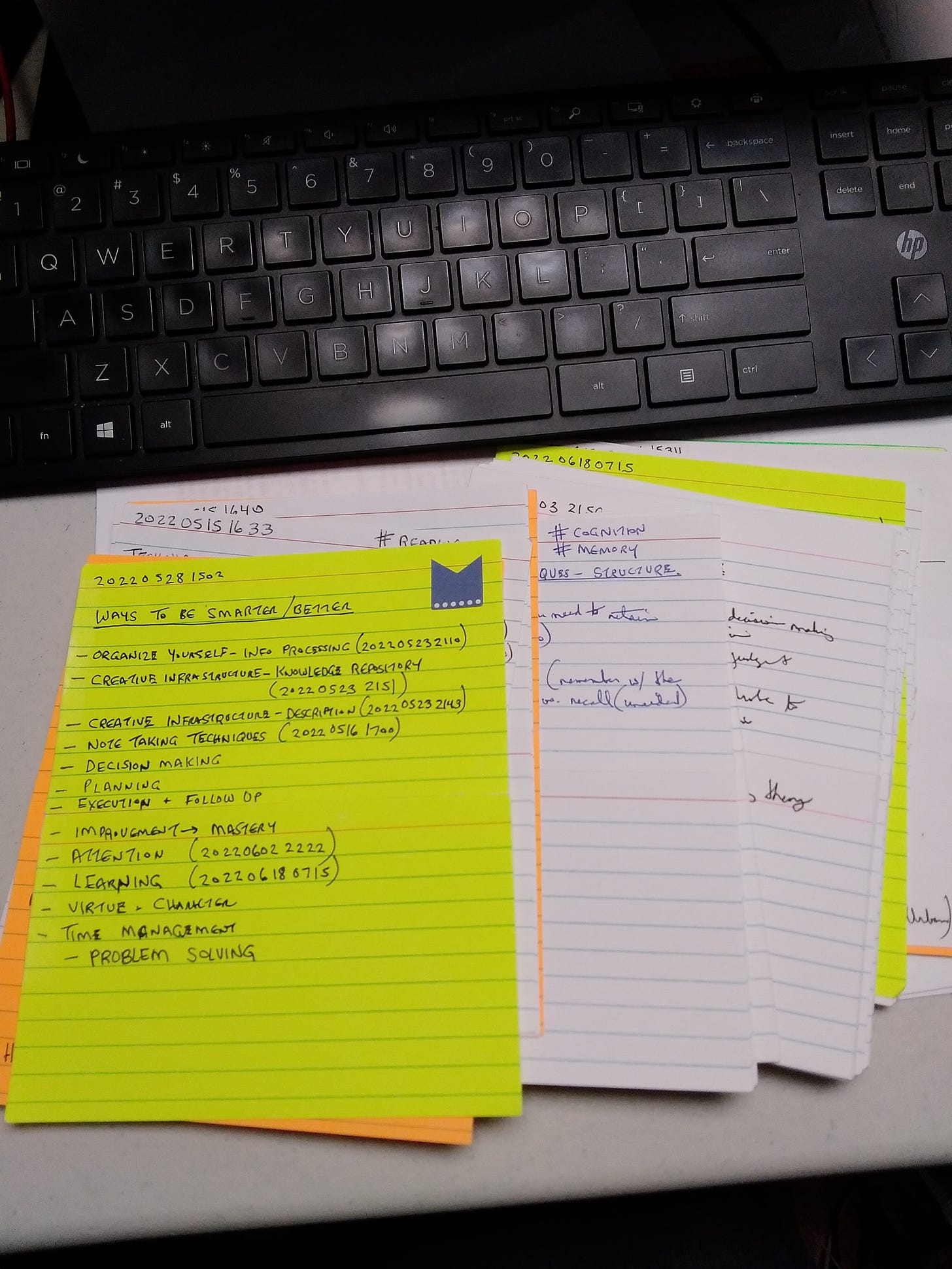
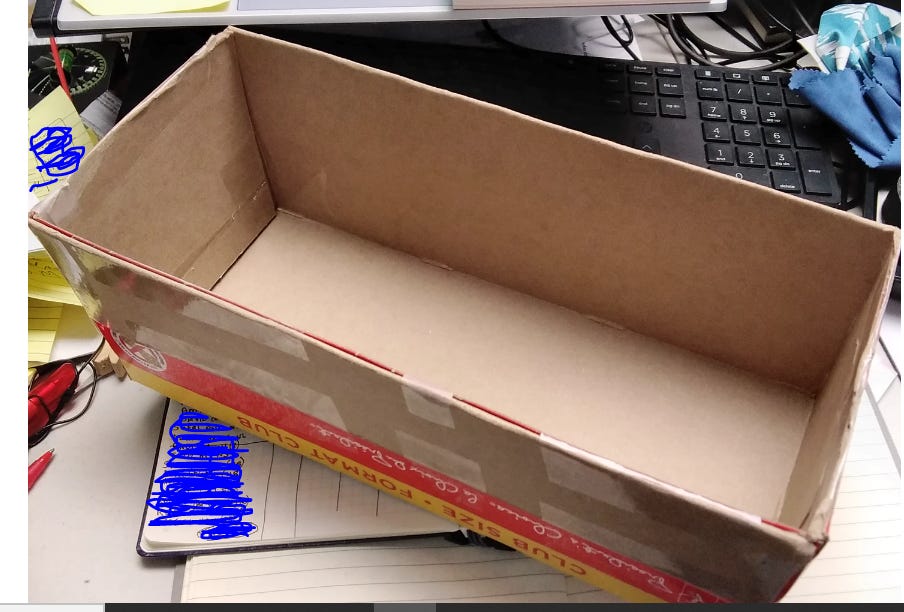
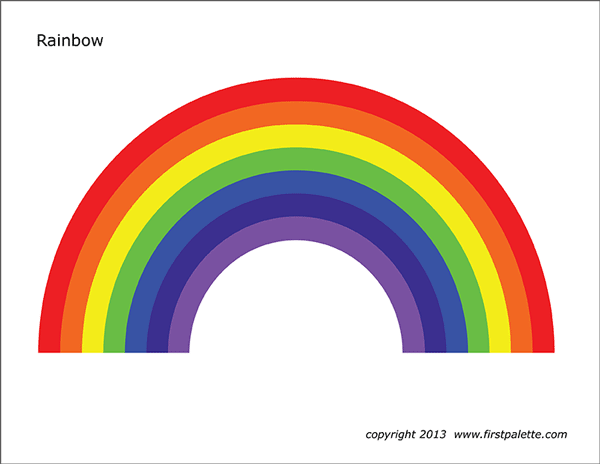
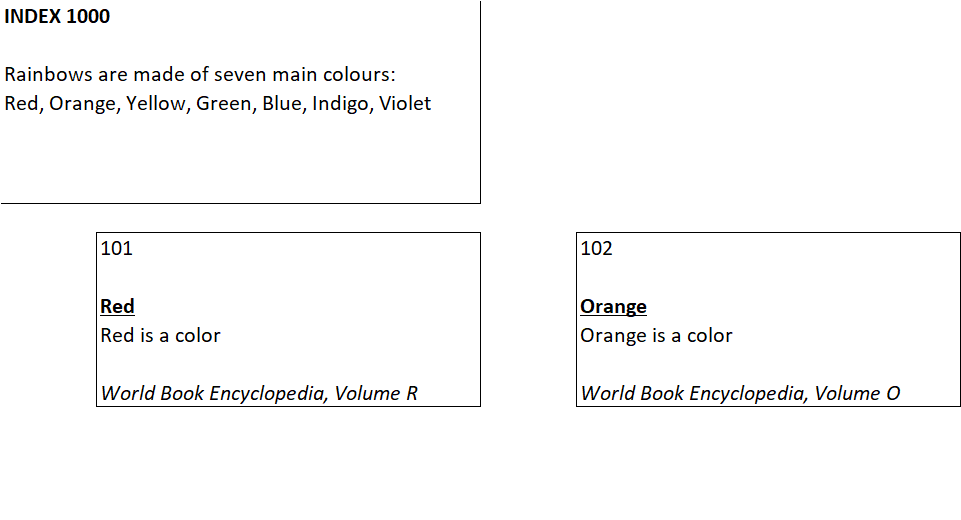

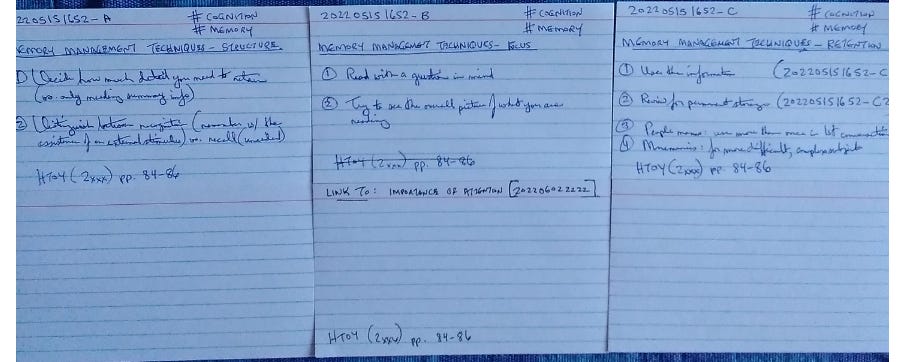
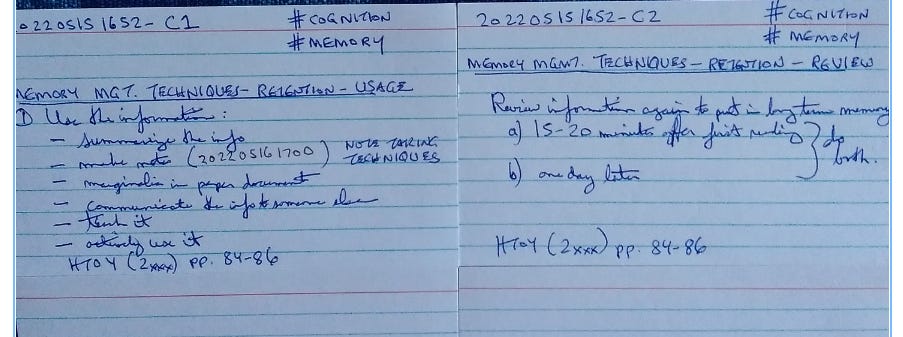
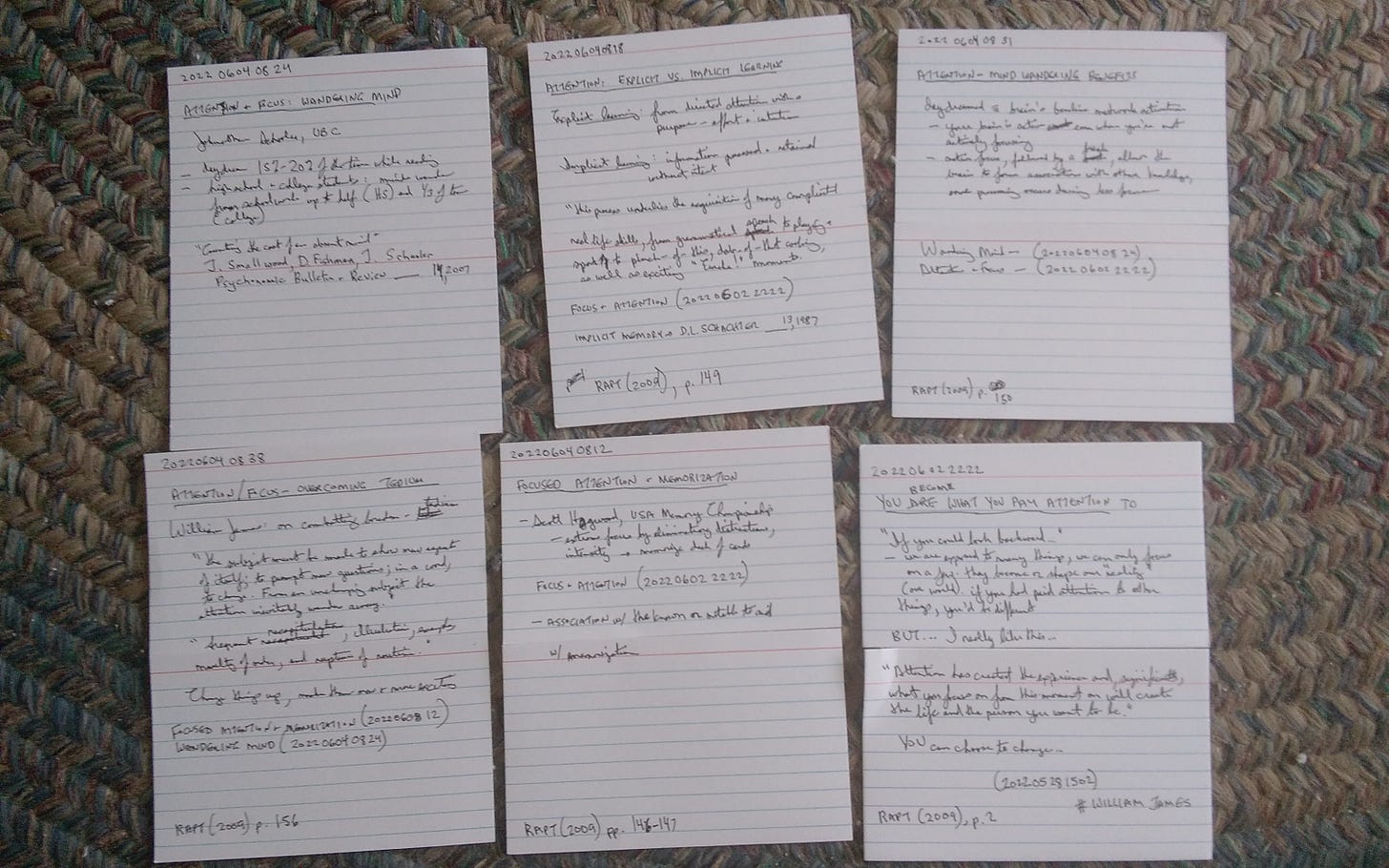

Wow - what an in-depth look!
I'm relatively new to Zettelkasten, but I'm not new at all to research and note taking. I started using Obsidian for novel writing about six months ago, and although I'm still trying to devise my own system, it's already working wonders.
One thing that you said really struck me: "I see connections between ideas more easily..." That's exactly the magic that happens for me. I started to see similarities between themes more clearly, and really got a sense of how the characters fit into the story by how they were connected to the other characters.
So not only does Zettelkasten give me a new way to organize my research and notes, it helps me see the bigger picture way more easily.
Great overview!
~Graham
Thank you for this! I’ve been using Miro for organizing and structuring thoughts and notes as it has great visuals and linking ability. But I’ve always gotten my best inspirations (and retention!) the old-fashioned way of pen and paper. My living room is littered with notebooks filled with scraps and tidbits.
Honestly, I’ve never heard of this method - actually never really looked for one - but it looks wonderful.
And a great use for all those shoeboxes kept for “just in case”...